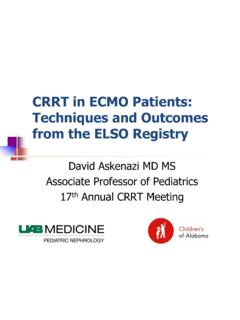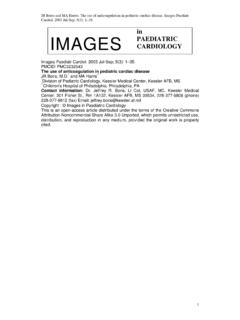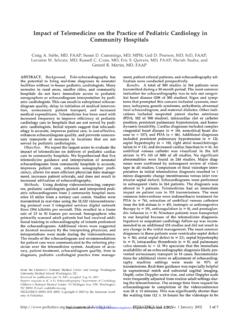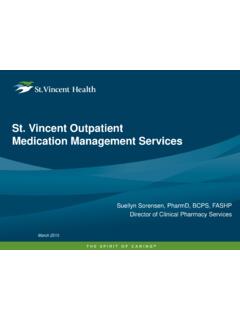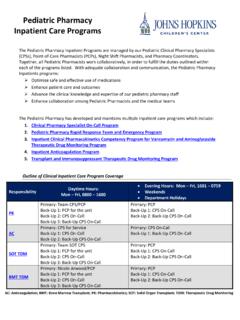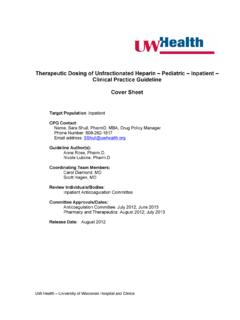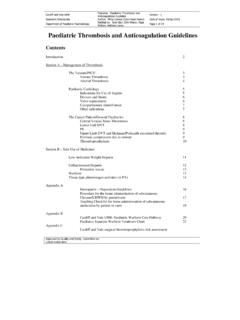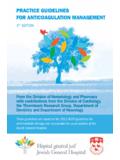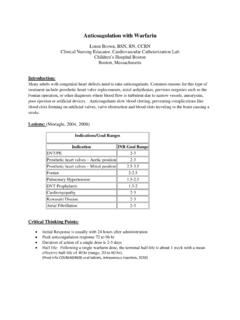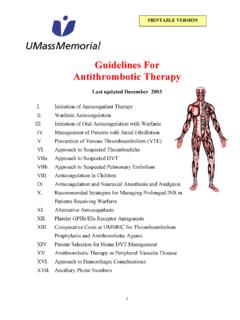Transcription of Pediatric CRRT The Basics
1 Pediatric crrt . The Basics Geoffrey Fleming Scott Sutherland Jordan Symons Michael Zappitelli 17th International crrt Conference San Diego 2012. Epidemiology Of and Indications For Pediatric crrt . Hospitalized patient Cardiac or other ER patient deteriorates surgery resuscitated ACUTE KIDNEY INJURY. HOW COMMON? WHO DOES IT. HAPPEN TO? WHO GETS IT? WHAT DO THEY GET? crrt . WHO SHOULD GET IT? Pediatric AKI: Definition Pediatric RIFLE (pRIFLE). Ackan-Arikan et al, Kidney International, 2007. Acute Kidney Injury Network Mehta et al, Crit Care Med, 2007. Pediatric AKI: Incidence in PICU. Population & Definition-dependent Cardiac Surgery N = 395 N=395. 70 90. 60 80. 70. 50. 60 AKI: 21%. 40 AKI: 34% 50. 30 40. 30. 20. 20. 10. 10. 0 0. No AKI R I F No AKI R I F. Kidney Int. 2009 Oct;76(8):885-92 Anesth Analg 2009;109:45 52. (Aprotinin study). Renal replacement therapy: 1 to 10% - crrt not very common Pediatric AKI: Incidence in PICU.
2 Population & Definition-dependent General PICU. Vasopressors+Ventilated All PICU stay>12hr All PICU admissions + Catheter N=150 N=2148 N=3396. 100 100% 100. 80%. 80 80% 80. 82% AKI 20% AKI 10% AKI. 60 60% 60. 40 40% 40. 20 20% 11% 20. 5% 4%. 0 0% 0. No AKI R I F No AKI Stage 1 Stage 2 Stage 3 No AKI R I F. Ackan-Arikan et al, Kid Int 2007; 71: 1028-35 Al-Kandari/Eddington, Crit Care, 2011 Schneider, Crit Care Med, 2010. Renal replacement therapy: 1 to 9% -- some receive crrt . crrt Diagnoses Mostly secondary renal disease USA USA. Other Spain: Much more in cardiac patients. Santiago et al, Int Care Med, 2010. Severe AKI tends to occur EARLY in PICU admission RRT Options Hemodialysis, Peritoneal Dialysis, crrt . Patient Characteristics Pediatr Nephrol (2009) 24:37 48. Disease/Symptoms Hemodynamic stability Strazdins et al, Pediatr Nephrol, 2004. Goals of therapy Fluid removal Electrolyte correction Both Availability, expertise and cost RRT Options Hemodialysis, Modality Peritoneal Dialysis, crrt .
3 Advantages Disadvantages Acute Hemodialysis Short treatment Vascular access necessary Patient Characteristics Accurate UF Hemodynamic instability Disease/Symptoms Heparin Pediatr Nephrol (2009) 24:37 48. Hemodynamic stability Peritoneal Dialysis No vascular access Less efficient Minimal equipment Variable UF. Goals of therapy Strazdins et al, Pediatr Nephrol, Minimal training 2004. Fluid removal Feasible small infants Electrolyte correction Continuous Both Continuous renal Accurate UF, continuous alterations Vascular access replacement therapy Availability, Smallerexpertise and cost circuit volumes Citrate anticoagulation Trends in Pediatric RRT. crrt use may be increasing in North America (Warady & Bunchman, Pediatr Nephrol, 2000). European guidelines (Strazdins et al, Pediatr Nephrol, 2004). 100 Singapore 100. USA. 90 90. 80 80. 70. % patients with RRT. 70. % patients with RRT.
4 60 60. PD. 50 PD 50 HD. CVVHDF. crrt . 40 40. 30 30. 20 20. 10 10. 0 0. 1980-95 Post-1995 1979-88 1989-1998. Gong et al, Ped Neph, 2001 Williams et al, Arch Ped Adol Med, 2002. Why crrt ? Deals well with hemodynamic instability Precise Volume control/immediately adaptable Effective control of uremia, hypophosphatemia, hyperkalemia, acid base balance Management of sepsis/plasma cytokine filter Allows for improved provision of nutritional support NUTRITION. Zappitelli et all, Crit Care Med, 2008. Indications for Pediatric RRT. Electrolyte (metabolic) imbalance Uremia with bleeding and or encephalopathy Acuity/Degree of Kidney Injury reduction in GFR/elevated creatinine reduction in urine output Nutritional support Intoxications, Inborn errors of Metabolism (IEM). Fluid Overload Fluid Overload (Total fluid in Total out)/ weight X 100 = FO %: Goldstein et al, Pediatrics Change in weight: Selewski et al, Intens Care Med, 2011.
5 45. %FO at CVVH Initiation 40. 35. 30. 25 p = 20. 15 Foland et al,Crit Care Med, 2009. 10. Hayes et al, J Crit Care, 2009. 5 Mean+SE. Mean-SE. 0 Selewski et al, Int Care Med, 2011. Death Survival Mean OUTCOME. MV analysis: FO mortality association independent of illness severity How much is too much? FO>10%. Gillespie et al, Pediatr Nephrol, 2004. Hayes et al, J Crit Care, 2009. Prospective Pediatric crrt Registry Critically ill children + crrt : FO% predicts mortality Sutherland et al, AJKD, 2010. crrt for FO. Pediatric Stem Cell Transplant with Acute Lung Injury Within 24-48 hours of crrt initiation: Elbahlawan et al, Pediatr Blood Cancer, 2010. Better oxygenation (PaO2/FiO2). More negative fluid balance Hoover et al, Intens Care Med, 2008. Timing of Pediatric RRT. ?????????????? Will depend on the patient, the individual physician and the place. Considerations Emerging importance of fluid overload prevention.
6 Children develop MODS and severe AKI early in ICU course Children die with MODS very early in ICU course Feasible in children Summary: Pediatric crrt . Epidemiology and Indications Pediatric AKI may be more common than previously described Primary renal disease giving way to MODS. crrt for children continues to expand Advantageous in critically ill child Effective Useful in setting of volume overload Best time to start remains uncertain crrt Terminology and Modalities Diffusion vs. Convection Diffusion is solute transport across a semi-permeable membrane - molecules move from an area of higher to an area of lower concentration Small molecules diffuse more readily than large molecules Convection is a process where solutes pass across the semi-permeable membrane along with the solvent in response to a positive transmembrane pressure Small and large molecules convect equally well; limit is membrane cut- off Current Nomenclature for crrt .
7 SCUF: Slow Continuous Ultrafiltration CVVH: Continuous Veno-Venous Hemofiltration CVVHD: Continuous Veno-Venous Hemodialysis CVVHDF: Continuous Veno-Venous Hemodiafiltration crrt Schematic R SCUF. CVVH. D. CVVHD. UF CVVHDF. crrt Machines Prescribing Pediatric crrt . Prescribing Pediatric crrt . Vascular access Hemofilter Prime Blood pump speed (QB). anticoagulation Ultrafiltration rate Infused fluids CVVH: Pre- and/or post-dilutional replacement CVVHD: Counter-current dialysate CVVHDF: Dialysate and replacement fluid Hemofilter for crrt . Hemofilter size Volume, porosity Membrane material Polysulfone, AN-69, PAES, etc. Tubing set integrated or separate? Open vs. closed systems do you have a choice? Priming the Circuit for Pediatric crrt . Blood Small patient, large extracorporeal volume Albumin Hemodynamic instability Saline Common default approach Self Volume loaded renal failure patient Choosing QB for Pediatric crrt .
8 Equation for blood flow rate (QB): 3-5ml/kg/min Choose from a table: 0-10 kg: 25-50ml/min 11-20kg: 80-100ml/min 21-50kg: 100-150ml/min >50kg: 150-180ml/min crrt device may affect choices for QB. The real determinant the vascular access Ultrafiltration in Pediatric crrt . Choose UF rate to balance input remove excess fluid over time make room for IV fluids and nutrition provide solute clearance by convection SCUF, CVVHD, post-dilution CVVH: UF rate may be limited by blood flow (filtration fraction). Pre-dilution CVVH: High flow of pre-dilution fluid lessens hemoconcentration Remember to consider UF limits of the filter, especially in higher-volume hemofiltration Ultrafiltration Rates No study has identified effective, safe UF. rates in children For HEMODIALYSIS NET UF rate of is tolerated This extrapolates to 1 ml/kg/ hr (NET UF) over 48 hr of continuous hemofiltration Donckerwolke Ped Neph 8:103-106,1994.
9 Infused Fluids for Pediatric crrt . SCUF: No infused fluids CVVHD: Counter-current dialysate CVVH: Pre- and/or post-dilution replacement fluid CVVHDF: Dialysate and replacement fluids Rate for Infused Fluid Higher rates increase clearance Lower rates may simplify electrolyte balance and limit protein loss Equations to help choose rate for fluid: 20-60 ml/kg/hr 2000-3000 ml/ May need higher rates to balance citrate delivery Characteristics of the Ideal crrt . Solution Physiological Simple to store Reliable Quick to the bedside Inexpensive Widely available Easy to prepare Fully compatible Purpose of crrt solutions Provide safe and consistent metabolic control To be adaptive to the choice of therapy- CVVH, CVVHD, CVVHDF. Options for crrt Solutions Peritoneal dialysate: NO. Pre-made IV solutions: MAYBE. Saline, Lactated Ringers Custom-made solutions: RARELY. Local pharmacy; outsource Commercially available crrt solutions Prevalence and Consequences of Errors in Solution Preparation 16/31 programs reported errors: 7 errors in replacement solutions 9 errors in dialysate solutions Consequences of improper solutions 2 deaths 1 non lethal cardiac arrest 6 seizures (hypo/hypernatremia).
10 7 without complications Barletta JF Pediatr Nephrol. 2006 Jun;21(6):842-5. What's the Difference Between Dialysate and Replacement Fluid? Dialysate is a Device Replacement Fluid is a Drug crrt Solutions Many Choices Name Company R / D Bag Size* Flavors Normocarb HF DSI R L 2. Prismasate Gambro D 5L 6. Accusol Baxter D L 5. Prismasol Gambro R 5L 7. Duosol B Braun D 5L 6. PureFlow NxStage D 5 5. *after mixing Summary: Prescribing Pediatric crrt . All modalities (SCUF, CVVH, CVVHD, CVVHDF) are available for treating critically ill children Newer solutions make crrt safer for children as they do for adults Devices and equipment are adapted for kids Special consideration for flow rates, based on Vascular access Vascular Access and anticoagulation for Pediatric crrt . Why Access function is crucial for therapy Flows obtained will affect adequacy of blood flow for dose delivered and can affect filter-circuit life Downtime from clotted circuits-access is time off therapy Access Considerations Low resistance Resistance ~ 8l /2r4.
